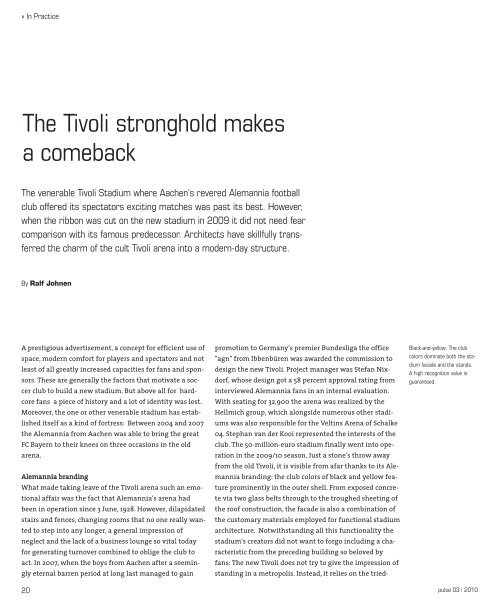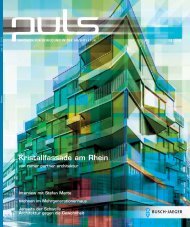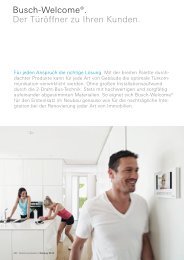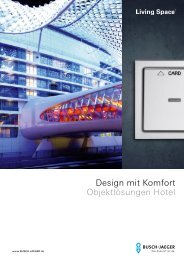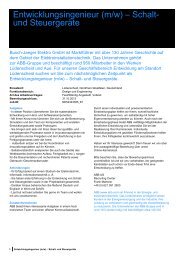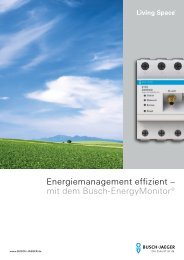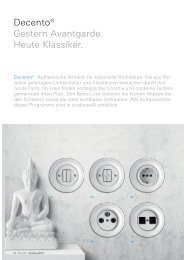Sports complexes that build identity - Busch-Jaeger Elektro GmbH
Sports complexes that build identity - Busch-Jaeger Elektro GmbH
Sports complexes that build identity - Busch-Jaeger Elektro GmbH
You also want an ePaper? Increase the reach of your titles
YUMPU automatically turns print PDFs into web optimized ePapers that Google loves.
» In Practice<br />
The Tivoli stronghold makes<br />
a comeback<br />
The venerable Tivoli Stadium where Aachen's revered Alemannia football<br />
club offered its spectators exciting matches was past its best. However,<br />
when the ribbon was cut on the new stadium in 2009 it did not need fear<br />
comparison with its famous predecessor. Architects have skillfully transferred<br />
the charm of the cult Tivoli arena into a modern-day structure.<br />
By Ralf Johnen<br />
A prestigious advertisement, a concept for efficient use of<br />
space, modern comfort for players and spectators and not<br />
least of all greatly increased capacities for fans and sponsors.<br />
These are generally the factors <strong>that</strong> motivate a soccer<br />
club to <strong>build</strong> a new stadium. But above all for hardcore<br />
fans a piece of history and a lot of <strong>identity</strong> was lost.<br />
Moreover, the one or other venerable stadium has established<br />
itself as a kind of fortress: Between 2004 and 2007<br />
the Alemannia from Aachen was able to bring the great<br />
FC Bayern to their knees on three occasions in the old<br />
arena.<br />
Alemannia branding<br />
What made taking leave of the Tivoli arena such an emotional<br />
affair was the fact <strong>that</strong> Alemannia's arena had<br />
been in operation since 3 June, 1928. However, dilapidated<br />
stairs and fences, changing rooms <strong>that</strong> no one really wanted<br />
to step into any longer, a general impression of<br />
neglect and the lack of a business lounge so vital today<br />
for generating turnover combined to oblige the club to<br />
act. In 2007, when the boys from Aachen after a seemingly<br />
eternal barren period at long last managed to gain<br />
20<br />
promotion to Germany's premier Bundesliga the office<br />
"agn" from Ibbenbüren was awarded the commission to<br />
design the new Tivoli. Project manager was Stefan Nixdorf,<br />
whose design got a 58 percent approval rating from<br />
interviewed Alemannia fans in an internal evaluation.<br />
With seating for 32,900 the arena was realized by the<br />
Hellmich group, which alongside numerous other stadiums<br />
was also responsible for the Veltins Arena of Schalke<br />
04. Stephan van der Kooi represented the interests of the<br />
club. The 50-million-euro stadium finally went into operation<br />
in the 2009/10 season. Just a stone's throw away<br />
from the old Tivoli, it is visible from afar thanks to its Alemannia<br />
branding: the club colors of black and yellow feature<br />
prominently in the outer shell. From exposed concrete<br />
via two glass belts through to the troughed sheeting of<br />
the roof construction, the facade is also a combination of<br />
the customary materials employed for functional stadium<br />
architecture. Notwithstanding all this functionality the<br />
stadium's creators did not want to forgo including a characteristic<br />
from the preceding <strong>build</strong>ing so beloved by<br />
fans: The new Tivoli does not try to give the impression of<br />
standing in a metropolis. Instead, it relies on the tried-<br />
Black-and-yellow: The club<br />
colors dominate both the stadium<br />
facade and the stands.<br />
A high recognition value is<br />
guaranteed.<br />
pulse 03 | 2010


